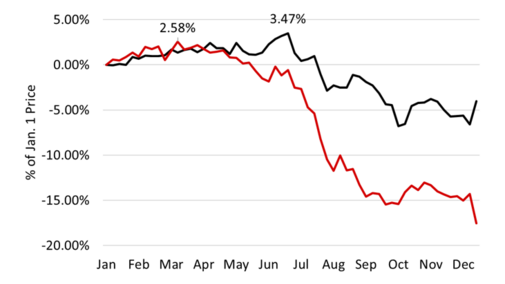Selling corn under $4.00/bushel is not fun for anyone, but it will be a reality for Nebraska producers this year. Despite low prices, there will be opportunities for savvy marketers. The 2018 marketing year is shaping up to be similar to 2017 for corn. Here we will review some the challenges producers faced in 2017 and how we can avoid them in 2018.
In 2017, corn accumulated a record amount of global ending stock, placing downward pressure on corn prices. Without a major market jolt, we can expect 2018 corn prices to be shaped by this large quantity of corn.
Challenges

- Basis: Because of the high volume of corn available, basis has been weak across the state. Grain buyers (elevators, ethanol facilities, feedyards) have access to plenty of grain and do not need to improve basis to attract farmers to sell. Remember basis values, especially for new crop, seldom change throughout the year. Furthermore, any changes that do occur are likely to be minimal (a few cents). Do not let a weak, unwavering basis keep you from selling grain when futures prices spike.
- Early futures price peak: Another symptom of high ending stocks, are that prices reach their peak much earlier in the year, February-April rather than April-June. Figure 1 compares a 20-year average percent price increase over January 1 to the average of years with “Very High” ending stocks. In 2017 many producers did not price corn early enough to capture seasonal highs.
- Unrealistic price targets: One barrier many farmers ran into in 2017, was that their pre-harvest price targets were too high. Producers had set target prices at and above $4.00/bushel cash in 2017. For most Nebraska farmers they had a small window, if any, to pre-price at this level.
Combating the Challenges
- Basis: There is little to nothing that individual farmers can do to improve the basis. However, this is a good time to consider which delivery locations are most profitable. Each grain buyer sets their own basis. Thus, shopping around your area for the best basis may help you gain a couple of cents. If you have the ability to haul grain to another area, you will want to calculate if the cost of hauling grain to receive the better cash price is worth the expense of hauling. For help in evaluating this cost, check out the University of Kentucky’s Grain Haul Decision Spreadsheet.
- Early futures price peak: Be prepared to sell grain early in 2018. Accept that you may be pricing a crop that you have yet to plant. Remember, in pre-harvest marketing plans it is not recommended that you forward contract or hedge 100% of expected production. The rule of thumb is to not pre-price more than insured production (Actual Production History (APH) times your percent of coverage). Most producers price 25%-50% of insured production.
- Unrealistic price targets: The market does not care if prices are below your cost of production until prices are so low that you decide not to produce anymore. Realistic target prices should be set based on grounded market expectations. The USDA releases the World Agriculture Supply and Demand Estimate monthly. In this report they predict farm prices for corn, soybeans and wheat, giving us a good gauge to set price targets. The December 12 USDA WASDE report estimates that national average cash price will be between $2.85 and $3.55/bushel.
This year will be a challenge for many grain producers. Having a written marketing plan that addresses the pitfalls outlined above will help keep you on track. For more grain marketing information check out the Economics and Marketing page in CropWatch.unl.edu.

